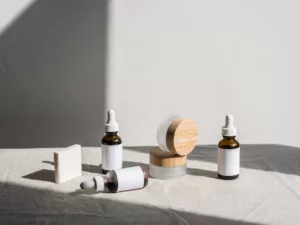What’s the Difference?

In recent years, the beauty industry has witnessed a significant shift towards clean beauty. As consumers become more conscious about the ingredients they put on their skin and the impact on the environment, the demand for clean beauty products has grown exponentially. But what exactly is clean beauty, and how does it differ from conventional beauty? In this blog, we’ll delve into the key differences between clean beauty and conventional beauty, empowering you to make informed choices for your skincare and makeup routine.
Clean Beauty: A Commitment to Purity and Safety
Clean beauty refers to products that are formulated with safe and non-toxic ingredients, free from harmful chemicals such as parabens, sulfates, phthalates, and synthetic fragrances. Instead, clean beauty brands prioritize natural and organic ingredients, often sourced sustainably and responsibly. These products are cruelty-free, not tested on animals, and their manufacturing processes are environmentally friendly.
The clean beauty movement advocates for transparency, with brands openly disclosing their ingredient lists and manufacturing practices. Consumers can easily identify clean beauty products by looking for certifications like EWG Verified™, Leaping Bunny, or USDA Organic.
Choosing clean beauty products comes with numerous benefits for both your skin and the planet. Clean beauty formulations are less likely to cause skin irritations and allergic reactions, making them suitable for sensitive skin types. The use of natural and nourishing ingredients can help improve skin health, leaving your complexion radiant and balanced.
Moreover, clean beauty embraces sustainability, using eco-friendly packaging and supporting ethical sourcing practices. By opting for clean beauty, you contribute to reducing your carbon footprint and supporting brands that prioritize environmental responsibility.
Conventional Beauty: Tradition and Innovation
Conventional beauty, on the other hand, refers to products that follow more traditional formulations and may contain synthetic or chemical ingredients. Many well-established beauty brands fall into the conventional category, offering a wide range of products that are easily accessible in most stores.
While conventional beauty products often promise immediate results and innovative technologies, they may also include potentially harmful substances. Some ingredients, like parabens and synthetic fragrances, have raised concerns about their long-term effects on health and the environment.
Conventional beauty products may deliver short-term results, but prolonged use of certain chemicals can lead to skin sensitivities and adverse reactions. Additionally, some ingredients in conventional beauty products may contribute to pollution and environmental degradation.
Understanding Labels: Navigating the Beauty Aisle
Reading beauty product labels can be a daunting task, but it’s crucial to know what you’re putting on your skin. Clean beauty products usually have straightforward ingredient lists, with recognizable plant-based extracts and natural oils. In contrast, conventional beauty products may contain a mix of natural and synthetic compounds, often listed using scientific names.
To make an informed choice, educate yourself about common harmful ingredients and opt for clean beauty alternatives. Look for certifications, check customer reviews, and consider the brand’s commitment to sustainability and ethical practices.

The Shift Towards Clean Beauty
The rise of clean beauty is not just a passing trend; it’s a reflection of the growing awareness of the impact of beauty products on our health and the environment. More and more consumers are demanding cleaner and safer alternatives, prompting conventional brands to reevaluate their formulations and practices.
As the demand for clean beauty grows, the industry is witnessing an influx of innovative and effective clean beauty products. From organic skincare to non-toxic makeup, clean beauty brands are proving that you don’t need to compromise on performance to achieve a healthy and radiant look.
Clean beauty and conventional beauty represent two distinct approaches to skincare and makeup. While conventional beauty embraces technological advancements and a wide range of products, clean beauty prioritizes purity, safety, and sustainability. The choice between the two ultimately depends on individual preferences and values.
As you navigate the beauty aisles, take the time to read labels, research ingredients, and choose products that align with your clean beauty goals. Embrace the clean beauty movement, and you’ll not only enhance your natural beauty but also contribute to a cleaner, greener, and more sustainable world.

